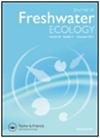Distribution of Miathyria marcella larvae (Odonata: Libellulidae) and water quality of wetlands in Northern Colombia
IF 1.3
4区 环境科学与生态学
Q3 ECOLOGY
引用次数: 0
Abstract
Abstract This study aims to assess the physicochemical characteristics regulating the distribution and abundance of M. marcella larvae in six wetlands in the northern Colombia. Standardized techniques for collecting invertebrate and physicochemical data were used in 29 sampling points in an intraannual period. Mean pH and temperature oscillated in narrow ranges within wetlands (7.7 ± 0.09–8.6 ± 0.07; 28.1 ± 0.29–32.8 ± 0.17 °C, respectively), whereas ammonium concentrations and conductivity exhibited a wide variation (0.2 ± 0.03–2.8 ± 0.54 mg NH4 L−1; 861 ± 30.7–19254 ± 1706 µS cm−1, respectively). A total of 2586 individual M. marcella larvae were collected. Abundance was greater in wetlands influenced by the Magdalena River, with 19.4 ± 1.7 and 9.3 ± 1.4 individuals; followed by wetlands hydrologically influenced by seasonal runoff, with 8.1 ± 0.4 and 6.4 ± 0.4 individuals; and lowest in wetlands with influence of the Caribbean Sea, with 3.9 ± 0.3 and 0.3 ± 0.1 individuals. Abundances of M. marcella larvae exhibited similar variations at different months during the sampling period. Abundance and distribution of M. marcella larvae in wetlands of northern Colombia is strongly dependent on water conductivity, transparency and alkalinity. This study evidence that Odonata larvae are a valuable tool as bioindicators for wetland assessment and monitoring.哥伦比亚北部湿地marcella Miathyria幼虫分布与水质
摘要本研究旨在探讨哥伦比亚北部6个湿地marcella M. marcella幼虫分布和丰度的理化特征。在一年中,在29个采样点使用了收集无脊椎动物和物理化学数据的标准化技术。湿地的平均pH值和温度波动范围较窄(7.7±0.09 ~ 8.6±0.07);(28.1±0.29-32.8±0.17°C),而铵离子浓度和电导率变化较大(0.2±0.03-2.8±0.54 mg NH4 L−1;861±30.7-19254±1706µS cm−1)。共采集到马尔塞拉小蠊幼虫2586只。受Magdalena河影响的湿地丰度较高,分别为19.4±1.7和9.3±1.4个体;其次是受季节径流影响的湿地,分别为8.1±0.4和6.4±0.4个体;受加勒比海影响的湿地最低,分别为3.9±0.3和0.3±0.1个体。在采样期间,不同月份的马尔塞拉菌幼虫丰度呈现出相似的变化。哥伦比亚北部湿地marcella幼虫的丰度和分布强烈依赖于水的导电性、透明度和碱度。研究结果表明,齿蛾幼虫可作为湿地评价和监测的重要生物指标。
本文章由计算机程序翻译,如有差异,请以英文原文为准。
求助全文
约1分钟内获得全文
求助全文
来源期刊
CiteScore
2.20
自引率
7.70%
发文量
34
审稿时长
3 months
期刊介绍:
The Journal of Freshwater Ecology, published since 1981, is an open access peer-reviewed journal for the field of aquatic ecology of freshwater systems that is aimed at an international audience of researchers and professionals. Its coverage reflects the wide diversity of ecological subdisciplines and topics, including but not limited to physiological, population, community, and ecosystem ecology as well as biogeochemistry and ecohydrology of all types of freshwater systems including lentic, lotic, hyporheic and wetland systems. Studies that improve our understanding of anthropogenic impacts and changes to freshwater systems are also appropriate.

 求助内容:
求助内容: 应助结果提醒方式:
应助结果提醒方式:


